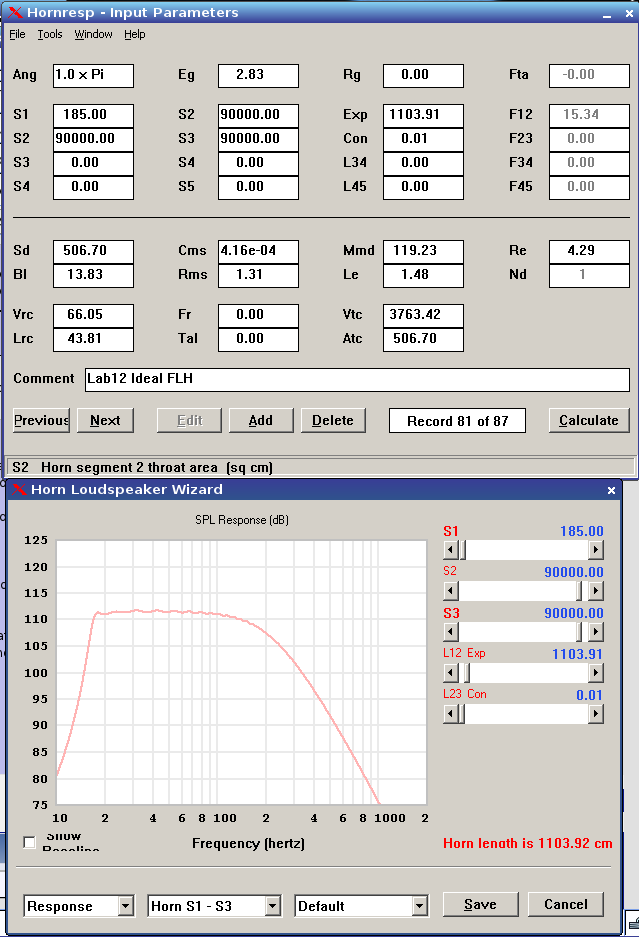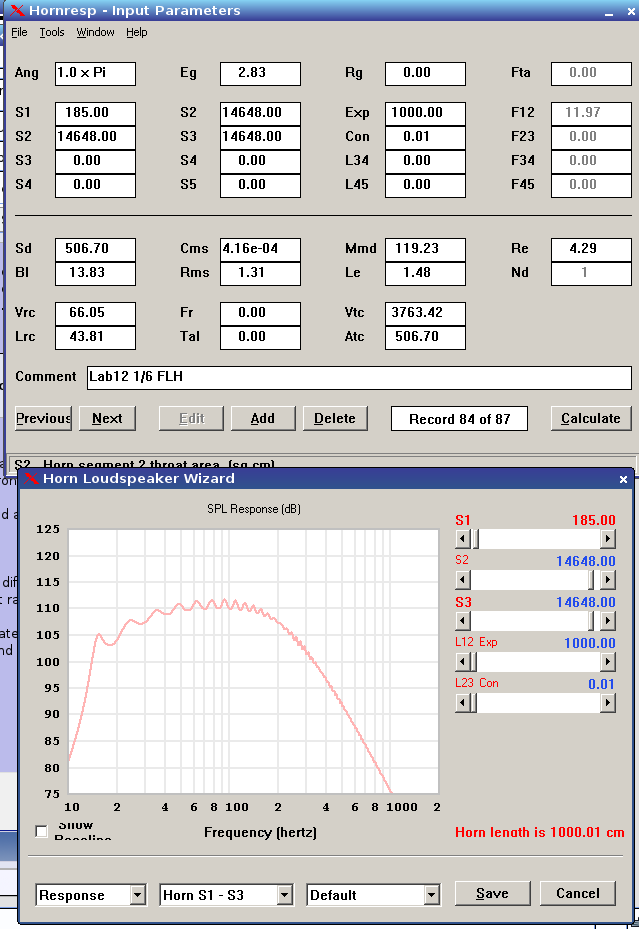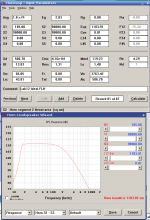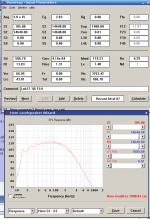Warning this is rather long and detailed. The meat of my questions is listed after the Bold text below.
As part of a church virtual organ project I am looking at sub options. Requirements include high output (and clean, don't want a Bourdon sounding like a Contra Bassoon) down to 16Hz firing into 50,000+ cubic feet.
Of course I looked at standard ported enclosures as well as Transmission Lines (standard and reverse taper). Although the TLs look like a nice compromise in size and output, it would probably require at least 4 15" long throw cabs and the modeling indicates that wild swings in output might be a problem as low as 40Hz making the low end requirements on the mains a bit stiff. It may well be that the model is worse than the reality after stuffing, but it got me thinking about using front loaded horns.
The speakers will be in chambers high up on both sides of the platform. Each chamber is large enough to hold three compact cars stacked on top of each other. The openings are about 6 feet wide by 7 feet tall.
I remembered reading about the Labhorns. Knowing that they are designed for much higher cut off, but also knowing that their low fs should support much lower frequency operation I set about modeling in Hornresp.
Of course the ideal horn has a mouth of about 90,000 cm^2 which is a bit ungainly. The flat response with max output of around 130dB using a single Lab12 driver is rather attractive though 😉. So then I looked at suboptimal versions and...
Here is the meat of the matter:
I started by cutting back the ideal horn to where the mouth area was 1/4 and 1/6 of ideal. Of course what I discovered is that the cut off frequency went up also along with the reduced output toward the lower end of the range and the increased ripple. I found that to get the same cut off I had to increase the length back almost (but not quite) to where I started. So...
1. When designing horns for stacking does one design for the same low end extension on the individual subs as on the ideal or does the stacking lower the cut off (including keeping the driver from unloading) of the system so that you can use the shorter horn length?
2. Does the interaction of the mouths reduce the ripple when stacked?
3. Would there be any advantage to making the horn path length slightly longer on one of the horns so that the peaks and troughs in the response counteract one another?
4. If the stacking does indeed lower the cut off frequency could one design the subs as ideal horns but at a higher cut off?
Please edumacate me here. 😉
Ideal Horn...

One Sixth size...

mike
As part of a church virtual organ project I am looking at sub options. Requirements include high output (and clean, don't want a Bourdon sounding like a Contra Bassoon) down to 16Hz firing into 50,000+ cubic feet.
Of course I looked at standard ported enclosures as well as Transmission Lines (standard and reverse taper). Although the TLs look like a nice compromise in size and output, it would probably require at least 4 15" long throw cabs and the modeling indicates that wild swings in output might be a problem as low as 40Hz making the low end requirements on the mains a bit stiff. It may well be that the model is worse than the reality after stuffing, but it got me thinking about using front loaded horns.
The speakers will be in chambers high up on both sides of the platform. Each chamber is large enough to hold three compact cars stacked on top of each other. The openings are about 6 feet wide by 7 feet tall.
I remembered reading about the Labhorns. Knowing that they are designed for much higher cut off, but also knowing that their low fs should support much lower frequency operation I set about modeling in Hornresp.
Of course the ideal horn has a mouth of about 90,000 cm^2 which is a bit ungainly. The flat response with max output of around 130dB using a single Lab12 driver is rather attractive though 😉. So then I looked at suboptimal versions and...
Here is the meat of the matter:
I started by cutting back the ideal horn to where the mouth area was 1/4 and 1/6 of ideal. Of course what I discovered is that the cut off frequency went up also along with the reduced output toward the lower end of the range and the increased ripple. I found that to get the same cut off I had to increase the length back almost (but not quite) to where I started. So...
1. When designing horns for stacking does one design for the same low end extension on the individual subs as on the ideal or does the stacking lower the cut off (including keeping the driver from unloading) of the system so that you can use the shorter horn length?
2. Does the interaction of the mouths reduce the ripple when stacked?
3. Would there be any advantage to making the horn path length slightly longer on one of the horns so that the peaks and troughs in the response counteract one another?
4. If the stacking does indeed lower the cut off frequency could one design the subs as ideal horns but at a higher cut off?
Please edumacate me here. 😉
Ideal Horn...
One Sixth size...
mike

